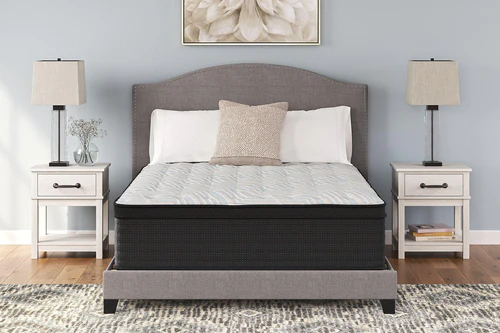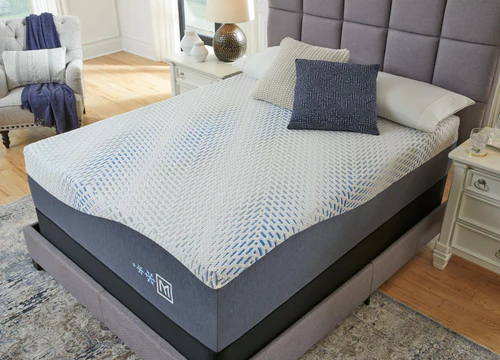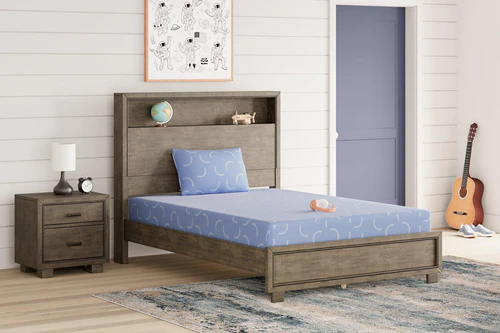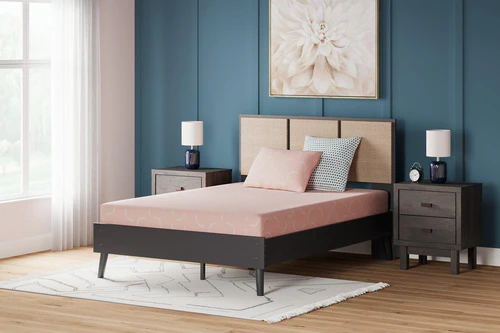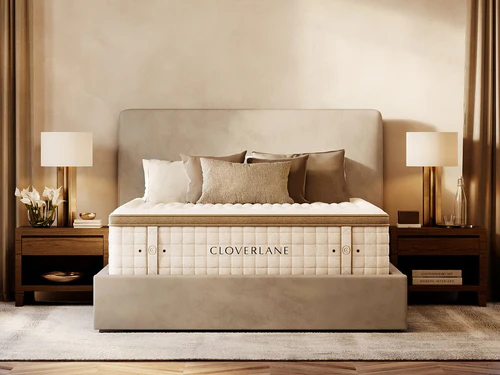How to Choose the Right Mattress for Ultimate Comfort
Choosing the right mattress for ultimate comfort is about considering your sleep needs, the types of mattresses, and the right firmness level. In this guide on how to choose the right mattress for ultimate comfort, we will help you navigate these factors to find the perfect mattress for a comfortable night’s sleep.
Key Takeaways
-
Recognize signs for mattress replacement, such as decreased sleep quality and visible sagging, to maintain optimal comfort and health.
-
Different mattress types (memory foam, innerspring, hybrid) cater to various sleep preferences, enhancing support and comfort based on individual needs.
-
Selecting the right firmness and mattress features, such as edge support and cooling technologies, is essential for achieving the desired sleep experience.
Signs It's Time for a New Mattress
Identifying when it’s time for a new mattress is vital for maintaining good sleep quality and overall health. A notable indicator is a decline in sleep quality. Tossing and turning all night or waking up feeling unrested often points to your mattress as the culprit. Over time, mattresses lose their ability to provide adequate support and comfort, leading to disrupted sleep patterns.
Waking up with body aches and pains is another clear sign. Mattresses typically wear out after about eight years, resulting in decreased comfort and support. Unexplained stiffness or soreness, especially in the back or neck, signals the need for a replacement. A mattress that fails to support your body properly can worsen these issues.
Visible sagging or indentations strongly indicate that an old mattress needs replacing. The materials in your mattress break down over time, causing it to lose shape and support. If you notice deep impressions where you usually sleep, this is a sign that your mattress is no longer providing the necessary support. Additionally, consider your pillows and mattress toppers, as they significantly influence sleep comfort.
A quality mattress significantly influences sleep quality, impacting health and well-being. Investing in a new mattress when these signs appear can dramatically improve your sleep and overall health. Don’t wait until the situation worsens—your body will thank you for the timely upgrade.
Understanding Mattress Types
Choosing the right mattress starts with understanding the different types available. The most popular options include memory foam, innerspring, hybrid, and latex mattresses. Each type offers unique benefits and is designed to cater to various sleep preferences and needs.
Memory foam mattresses mold to the body, offering exceptional pressure relief. In contrast, innerspring mattresses feature steel coil support systems, providing traditional firmness and bounce. Hybrid mattresses combine the supportive nature of innerspring with the comfort of foam, offering a balanced sleep experience. Additionally, spring mattresses are another option to consider for those seeking a different feel.
Understanding these mattress types helps in making an informed decision. Whether you need a mattress that contours to your body, provides a bouncy feel, or offers a mix of both, knowing your options is the first step toward finding your perfect mattress.
Memory Foam Mattresses
Memory foam mattresses are popular for contouring to the body, providing pressure relief, and supporting spine alignment. They are particularly beneficial for side sleepers and those with back pain, as they alleviate pressure points and distribute body weight evenly.
Predominantly made of plush memory foam, these best mattresses offer a cradling feel that many find comfortable. However, adapting to the softness of memory foam may take time. One downside is that memory foam can trap and absorb body heat, affecting sleep comfort, especially for those who sleep hot. A mattress topper can enhance the overall comfort of your sleep experience.
Memory foam mattresses excel in motion isolation, making them ideal for couples. The material absorbs movement, ensuring one partner’s movements do not disturb the other, combined with pressure-relieving properties, making memory foam a popular choice for a supportive and comfortable sleep experience.
When shopping for a memory foam mattress, consider the density and thickness of the foam layers. Higher density foams offer better support and durability, while thicker layers enhance comfort. Options with cooling technologies, such as gel-infused memory foam, mitigate heat retention and enhance sleep quality.
Innerspring Mattresses
Innerspring mattresses are known for being bouncy, supportive, and firm, featuring connected metal springs or coils and a top layer of soft padding. These traditional innerspring mattresses are best recommended for back sleepers, stomach sleepers, and heavier sleepers, providing a feeling of being held up rather than sinking in on an innerspring bed.
A key benefit of innerspring mattresses is their excellent edge support. This feature ensures stability and allows users to utilize the full surface without feeling like they might roll off. Additionally, many innerspring mattresses contain foam layers for cushioning while maintaining the coil effects. However, they are not as effective in providing pressure relief as other types of mattresses.
Innerspring mattresses are generally accessible, typically ranging between $600 and $1,200. This affordability, combined with their supportive nature, makes them a popular choice for many sleepers. When choosing an innerspring mattress, consider the gauge of the coils and the quality of the materials used to ensure durability and comfort.
Hybrid Mattresses
Hybrid mattresses combine foam layers with coils for pressure relief and support. This combination allows for better airflow compared to all-foam options, enhancing breathability and temperature regulation. By blending the bounce from coils and the pressure relief from foam or latex, hybrid mattresses offer a balanced sleep experience.
These mattresses alleviate the drawbacks of all-foam and innerspring beds, providing a mix of comfort and support that suits a variety of sleepers. Hybrid mattresses are particularly ideal for back sleepers and combo sleepers who require varied support throughout the night. For example, back sleepers may prefer latex foam within hybrid mattresses for better spinal alignment.
When choosing a hybrid mattress, consider the quality of both the foam and coil components. High-quality hybrids, like the Leesa Sapira Chill Hybrid and Bear Elite Hybrid, offer enhanced support and pressure relief, making them a versatile option for many sleepers.
Choosing the Right Firmness Level
Selecting the right firmness level is key to achieving desired comfort and avoiding pressure points. Mattress firmness is measured on a scale from 1 to 10, where 1 is very soft and 10 is very firm. The right firmness level is influenced by sleeping position and body weight. Lightweight individuals often prefer softer mattresses, while heavier individuals typically require firmer options for adequate support.
To maintain proper spinal alignment while sleeping, consider the following factors:
-
Choose a firmness level that keeps the spine mostly straight with a subtle inward curve.
-
Ensure the mattress’s support level reflects the sleeper’s body weight and sleeping position for optimal comfort.
-
Side sleepers may prefer a softer mattress to relieve pressure on the shoulders and hips.
-
Back and stomach sleepers often benefit from firmer mattresses.
Balancing firmness with comfort is essential for a satisfying sleep experience. Testing different firmness levels and considering personal preferences will help you find the perfect mattress that supports your body and enhances sleep quality.
Sleeping Positions and Mattress Selection
Different sleep positions require specific mattress features to ensure comfort and support. For instance, back sleepers need a mattress that supports the spine, side sleepers need softer surfaces to relieve pressure on the hips and shoulders, and stomach sleepers require a firmer mattress to prevent the spine from sinking and maintain proper alignment.
Understanding your preferred sleep position is key when choosing a mattress. Selecting a mattress designed to support your sleep style ensures better spinal alignment, reduced pain, and improved sleep quality.
Here are the specific needs of side and back sleepers, as well as stomach sleepers.
Back Sleepers
Back sleepers typically benefit from medium-firm mattresses to ensure proper spinal alignment and support. These mattresses prevent the lower back from sinking too deeply while providing enough give to contour to the body. A firmness level between medium (5) and firm (8) is recommended for back sleepers to balance comfort and support, making the medium firm model an ideal choice.
Back sleepers usually need an adjustable bed frame shredded foam pillow that provides proper neck support, as a poorly chosen pillow can lead to back and neck aches. A back sleeper should ensure their spine contacts the mattress at the head, shoulders, lower back, and hips without gaps for proper alignment.
Memory foam mattresses provide pressure relief and a cradling feel, which can be particularly beneficial for back sleepers. The Plank Firm mattress helps keep the spine straight with minimal sinkage, making it suitable for back sleepers.
Side Sleepers
Side sleepers often need a mattress that is softer to reduce pressure on the shoulders and hips. A firmness level ranging from soft (3) to medium firm (6) is recommended for side sleepers, as this range provides the necessary contouring to relieve pressure points.
The contouring nature of memory foam helps in alleviating pressure points, particularly beneficial for side sleepers. Softer mattresses provide deep pressure relief for hips and shoulders, essential for side sleepers’ comfort.
Adequate pressure relief is crucial for side sleepers to ensure a comfortable and restful sleep. Softer mattresses are especially helpful for those with shoulder or hip pain, providing the necessary cushioning to alleviate discomfort.
Stomach Sleepers
Stomach sleepers generally benefit from firmer mattresses to maintain proper spinal alignment. A firmness level between 7 to 9 out of 10 is suggested to prevent the hips from sinking below the shoulders, which can cause misalignment and discomfort.
A firmer mattress for back pain is recommended to alleviate hip or back pain for stomach sleepers. Adequate support prevents the spine from curving unnaturally, reducing the risk of pain and discomfort.
Stomach sleepers require a firmer and more supportive mattress for comfort and proper alignment. This firmness helps maintain a neutral spine position and prevents excessive sinking, ensuring a good night’s sleep.
Additional Features for Ultimate Comfort
Beyond choosing the right mattress type and firmness, several additional features can enhance overall comfort. Edge support, cooling technologies, and motion isolation are key features that contribute to a more comfortable sleep experience.
Edge support maximizes the usable area of the mattress and prevents sagging. Cooling technologies, such as gel-infused foams and breathable materials, help regulate temperature for hot sleepers and enhance overall comfort. Motion isolation refers to how well a mattress absorbs movement, ensuring undisturbed sleep, especially for couples.
These features can significantly improve sleep quality and overall comfort. Considering these additional features helps you choose a mattress that meets all your comfort needs.
Edge Support
Edge support is crucial for maximizing the usable area of a mattress, allowing users to utilize the full surface effectively. A strong solid edge support system ensures stability and prevents users from experiencing the feeling of rolling off the mattress.
Foam mattresses can achieve good edge support by using denser foam materials in the perimeter. This extra support around the edges can enhance the overall durability and comfort of the all foam mattress, making it a valuable feature to consider.
Cooling Technologies
Sleeping hot at night can be attributed to the materials in your mattress, particularly if it’s made from memory foam. Some memory foam mattresses are infused with cooling agents to counteract heat retention. Cooling technologies in mattresses aim to enhance airflow and dissipate heat, creating a more comfortable sleep environment for hot sleepers.
Air channels or gel, copper, or graphite infusions in foam mattresses can help with heat transfer. For instance, the Brooklyn Bedding Aurora Luxe features a cool-to-the-touch cover with copper and gel-infused foams, improving temperature regulation.
Hybrid mattresses often combine mattress materials like gel-infused foams and breathable fabrics to provide effective temperature regulation.
Motion Isolation
High-quality motion isolation minimizes disturbances from one partner’s movements, benefiting couples who share a bed. Memory foam mattresses typically excel in motion isolation due to their ability to absorb movement. For example, the Brooklyn Bedding Aurora Luxe scores 8 out of 10 for motion isolation, making it a great option for couples.
The DreamCloud Premier Rest also performs well, receiving an 8 out of 10 rating for motion isolation. The Helix Midnight Luxe mattress is rated highly for motion isolation, providing minimal disturbance during sleep.
Choosing a mattress with excellent motion isolation can significantly improve sleep quality, especially for couples.
Mattress Size Considerations
When choosing a mattress size mattress, consider the layout of your room to ensure comfortable movement and space for other furniture. Leave at least 24 to 36 inches of space around the mattress for ease of movement. Couples typically benefit from the expansive space of a queen or king mattress.
Taller individuals may prefer extended mattress sizes such as Twin XL or California King for added length. Family-sized mattresses can accommodate multiple sleepers, providing ample space for parents and children. When selecting a mattress, take future needs into account, as life changes may affect your space requirements.
Choosing the right mattress size balances personal comfort with practical room considerations. Ensure you have enough space to move around freely and accommodate any other necessary furniture in your bedroom.
Budgeting for Your Mattress Purchase
Understanding what affects mattress pricing helps align your budget with your sleep needs. When budgeting, consider the longevity of a mattress and any warranties offered. A decent mattress can range from $600 to $1,000, balancing comfort and durability.
The typical price range for mid-range mattress models is $500 to $1,500. The price zone of $1,000 to $1,500 is often considered the sweet spot for a queen-size bed. Investing more in a mattress can enhance sleep quality and overall health. Holiday sales events often offer significant savings on mattress purchases.
Comparing different mattress brands and models is essential for making an informed mattress purchase. Online shopping often offers better mattress deals and promotions compared to in-store purchases. Taking advantage of these opportunities helps you find a high-quality mattress that fits your budget and meets your sleep needs.
How to Test a Mattress Before Buying
Sleep trials are crucial for determining if a mattress’s firmness suits your needs, as comfort can evolve over time. Firsthand testing and analysis of mattress design and firmness is a key method for evaluating a mattress. Spending sufficient time testing a mattress in-store, ideally around 10 minutes, is crucial for a proper evaluation.
When testing a mattress, check for edge support by sitting on the edge to ensure stability and lying down to confirm you don’t slide off. Assess back support by lying on your back to ensure the spine remains neutral and that hips and shoulders are adequately supported. Evaluate motion isolation, especially for couples, to see how movements affect the partner’s side when one shifts.
A mattress’s firmness can vary by brand, so compare against a standard firmness scale for clarity. Gathering feedback from extensive mattress tests contributes to accurate assessments of performance and user satisfaction over time.
Mattress Care and Maintenance
A mattress protector shields the mattress from spills and dust mites. Regularly changing your sheets prevents dirt and allergens from seeping into the mattress. Clean your mattress every six months to maintain hygiene and longevity. Routine cleaning and maintenance, including vacuuming, can significantly extend a mattress’s useful life.
Different mattress types have specific rotation guidelines; foam and latex should typically be rotated every 6 to 12 months. Inadequate support can cause a mattress to wear out faster and void its warranty. Latex mattresses have a longer lifespan, typically lasting between 7.5 to 8.5 years.
Proper care and maintenance can prolong the life of your mattress, ensuring it continues to provide the support and comfort you need for a Good Night’s Sleep.
VOCs and Off-Gassing
VOCs, or volatile organic compounds, are released from new mattresses, causing unpleasant odors. These VOCs can pose potential health risks, making awareness critical for consumers. Choosing a mattress certified by organizations like CertiPUR-US can reduce the risk of harmful chemical exposure.
Not all mattress labels are trustworthy; for example, ‘natural’ does not necessarily mean the mattress is free from harmful chemicals. Being informed about VOCs and off-gassing can help you make safer and healthier choices when purchasing a new mattress.
Get The Right Mattress At Golden Linens & Furniture Today!
Golden Linens & Furniture offers a wide range of high-quality mattresses, including memory foam, hybrid, and innerspring options, catering to various sleep preferences. The store provides affordable mattresses with flexible financing options, including 0% interest and lease-to-own programs.
Golden Linens & Furniture is located in Philadelphia, making it a convenient option for local customers. The store offers mattresses in all standard sizes, including Twin, Full, Queen, King, and California King, to accommodate different room sizes and needs.
Golden Linens & Furniture emphasizes expert advice to help customers select the best mattress suited to their individual sleep styles. Visit today to find the perfect mattress that will transform your sleep quality and overall well-being.
Summary
Choosing the right mattress is a deeply personal decision that impacts your sleep quality and overall health. Recognizing the signs that it’s time for a new mattress, understanding the different types available, and selecting the right firmness level are crucial steps in finding your perfect mattress.
Your sleeping position plays a significant role in determining the right mattress, and additional features like edge support, cooling technologies, and motion isolation can enhance your sleep experience. Proper care and maintenance, awareness of VOCs and off-gassing, and testing mattresses before purchasing are essential practices for ensuring long-term comfort and satisfaction.
Golden Linens & Furniture offers a wide range of options to cater to diverse sleep preferences. By following the expert tips provided in this guide, you can make an informed decision and enjoy the ultimate comfort and support from your new mattress.
Frequently Asked Questions
How do I know if it’s time to replace my mattress?
It’s time to replace your mattress if you experience poor sleep quality, wake up with body aches, or notice visible sagging. Generally, mattresses should be replaced every eight years to maintain optimal comfort and support.
What is the best mattress type for side sleepers?
The best mattress type for side sleepers is typically a softer option, like memory foam, as it offers essential pressure relief for the shoulders and hips. This helps ensure a comfortable and supportive night's sleep.
How can I test a mattress before buying?
To effectively test a mattress before purchasing, spend at least 10 minutes lying on it to assess comfort and support, paying attention to edge support and motion isolation. Additionally, consider opting for stores that provide sleep trials for further assurance.
What are VOCs, and why should I be concerned?
VOCs, or volatile organic compounds, are chemicals emitted from products like new mattresses that can lead to unpleasant odors and health risks. To minimize exposure, it's advisable to choose certified mattresses.
How can I prolong the life of my mattress?
To prolong the life of your mattress, use a mattress protector, rotate it regularly, and clean it every six months. These practices will significantly enhance its durability and comfort.

